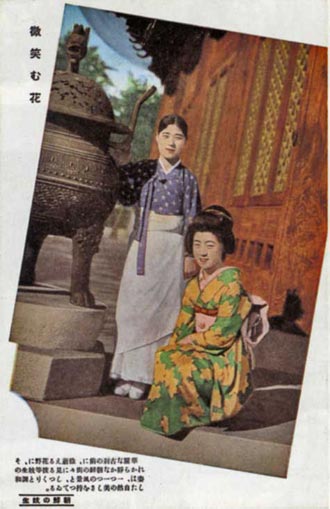E. Taylor Atkins
Primitive Selves: Koreana in the Japanese Colonial Gaze, 1910-1945
University of California Press
280 pages, 9 x 6 inches
ISBN 978 0520266735
ISBN 978 0520266742
Primitive Selves offers a different take on the history of Japanese colonial rule in Korea. Whereas most studies focus on specific policies—such as economic exploitation, compulsory education, assimilation directives, military mobilization, mechanisms of social control, and suppression of nationalist resistance—designed to erase indicators of an independent Korean national identity, this book examines this imperial relationship from the perspective of culture.
I argue that, alongside the brutality of Japanese colonialism in Korea, there was a parallel—if contradictory—impulse to document, preserve, and exhibit selected aspects of Korean folkloric culture and performance art.
I contend that the attraction many Japanese felt toward Koreana was an expression of an anti-modern ambivalence, a nostalgic longing for a primordial, elemental lifestyle abandoned in the rush to modernize.
Because colonial ideology and ethnological science posited the ancient ethnic kinship of the two peoples, for Japanese, gazing on Koreans was like looking in a mirror through a time warp.
The Japanese gaze on Koreana, moreover, transformed Koreans’ sense of the importance of their own cultural traits and expressive forms, rendering them into emblems of nationality worthy of official recognition by the post-liberation Korean states.
Individual chapters make these points by focusing on Japanese verbal and photographic ethnographies of Koreans, official curatorial endeavors to preserve and display Koreana, and the prevalence of Korean music, dance, and kisaeng iconography in imperial Japanese mass media culture (which prefigured the “K-Wave” of early 21st century).
While it is certainly not my intent to “correct” the narrative of Japanese cruelty in colonial Korea, I do present abundant evidence that prominent Japanese were entranced by Korean arts and culture. This fascination indicates a degree of self-reflection—even self-loathing—among Japanese who were not so enchanted with their own modernity.

Alongside the brutality of Japanese colonialism in Korea, there was a parallel—if contradictory—impulse to document, preserve, and exhibit selected aspects of Korean folkloric culture and performance art.
My first book was a sweeping history of jazz music in Japan. I also edited a collection, entitled Jazz Planet, that attempts to “globalize” jazz historiography.
So Primitive Selves is a real departure for me. The book required that I catch up in several fields in which I had little or no prior training: modern Korean history, historiography and theory of colonialism, history of anthropology and ethnomusicology, cultural resource management and museology, and public remembering and commemoration. I have joked that it was like being in graduate school again, but without the time to devote to my studies (this makes overworked graduate students cringe).
Still, Primitive Selves has its origins in my fondness for some genres of Korean folk music, specifically p’ansori (solo narrative singing) and p’ungmul drumming. I was introduced to these at a professional development institute on Korean culture and society at the East-West Center in 2000. As a Japan specialist, I naturally wondered how the colonial government responded to Korean expressive forms, especially since so much of their content had traditionally been satirical, subversive, and critical of authority. Undocumented, cursory references to the “suppression” of p’ansori sparked my interest further, and I ran with it.
In terms of its broader meaning, I do hope that the book will open up more dialogue between Koreans and Japanese about the colonial period—and dialogue also among the scholars who study them; dialogue less impassioned and indignant, and more reflective and nuanced.
It is striking how much nationalistic vitriol still poisons the exchanges between the two nations with regard to their shared history. Some enraged Koreans continue to castigate Japan for virtually every woe, while haughty Japanese rightists regard the Koreans as ingrates, who don’t appreciate the “leg up” Japanese colonial development gave them to become a major industrial power.
I believe historical investigation is a moral enterprise, not in the sense that it guides us specifically what to do or not do to address quandaries we face, but rather to lay out for us problems our ancestors encountered, and what worked and did not work in their efforts to address them.
In the case of the Japan-Korea relationship, most people speculate counterfactually about whether or not Koreans could have modernized on their own, without imperial interference—from Japan or elsewhere. This seems to me to be the wrong question; it is certainly not answerable in any persuasive way.
The problem here, for both countries, was the threat of imperial exploitation and violence from Europe and the United States in the mid-nineteenth century, which provoked Japan to embark on its own campaign of imperial posturing and intimidation.
Once colonial annexation occurred, some Koreans reacted violently—assassinating the first Resident General, engaging in guerilla warfare, and attempting even to murder the Japanese emperor. All of these simply made Japanese tighten their grip.
The point is, then, the counter-productivity of retaliating against violence with violence—a moral dilemma we see illustrated daily in the contest between self-proclaimed jihadis and their enemies du jour.
Postcard showing a Korean kisaeng and a Japanese geisha, two iconic figures rarely juxtaposed in visual media. Reproduced in the book Kiisen: “mono iu hana” no bunkashi by Kawamura Minato (Tokyo: Sakuhinsha, 2001; plate 10)

The first chapter, “A Long Engagement,” provides a narrative overview of the Japan-Korea relationship until the end of World War II.
I could have relied exclusively on secondary works by other historians who have written immense amounts about this period of history. However, I supplemented such work with contemporary reports from the U.S. and Japanese media, to inch somewhat closer in time to the action.
Such sources are not without their own problems, of course. One easily detects racism and outright contempt in them. Nonetheless, in these reports I found so much more texture and color, more impassioned opinions and poignant quotations than any historical narrative provided. This reinforced for me the power of using primary sources as proximate to the events and people as one is able to obtain. The result is a substantially different narrative of colonial Korean history than one is likely to find elsewhere.
Moreover, I reassess the meanings of the slogan “cultural rule” (bunka seiji), used by the Japanese to characterize a shift in colonial policy after the 1919 national uprisings in Korea. I also argue that the desire to document and curate Koreana was an imperative throughout the colonial period, rather than an ephemeral, unsustained project of the purportedly “liberal” 1920s.
Some readers might enjoy chapter 4 the most: this recounts how Korean folk music and dance became mass cultural products in 1930s Japan, around the same time that pressures to assimilate Koreans to Japanese culture intensified.

None of us is anything less than a complex whole, and we do well to acknowledge the comparable complexity of the people whose historical traces we pursue.
My intention is to communicate information about the past in a manner that is intelligible, informative, and thought-provoking to non-historians. If the reader also enjoys reading, then so much the better.
One of my fears all along with this project has been that it might offend Koreans. I iterate throughout the book: I am not trying to minimize their national suffering, nor exonerate Japanese somehow by pointing out the affection and interest many of them had in Koreana.
But I am not inclined to endorse or promote Manichean views of life, either in the past or present. I do believe there is good and evil, but I don’t think my primary responsibility as a historian is merely to revere the good and castigate the evil.
I think the message is conveyed more effectively when presented in a calmer, more nuanced way. None of us is anything less than a complex whole, and we do well to acknowledge the comparable complexity of the people whose historical traces we pursue.
Finally, I have pledged to donate 100% of my royalties from Primitive Selves to Tahirih Justice Center, a charity that arranges pro bono legal, social, linguistic, and medical services for immigrant women and girls who are victims of gender-based violence, trafficking, and abuse.




We don't put paywalls. We don't distract you with ads. We don't sell your data.
Please help to keep this running!